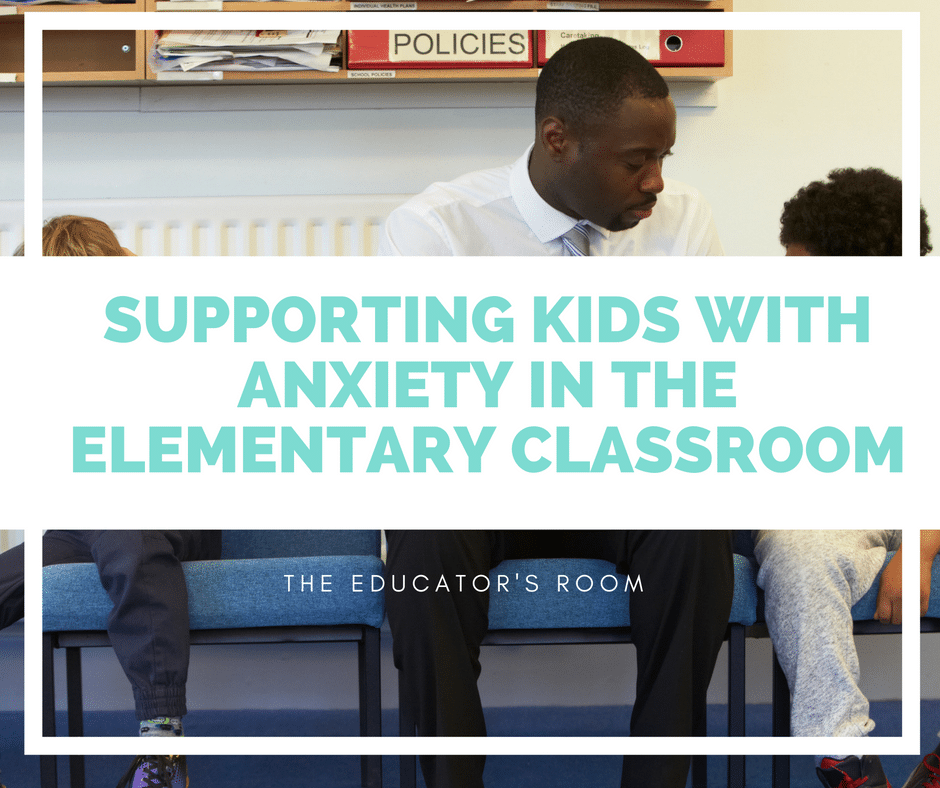Guest Post by: Cindy Bourdo, NBCT
As each new school year begins, I seem to get a few more students than the previous year in my classroom who suffer from anxiety. It is not always a formal diagnosis, but I usually hear about it from previous teachers or parents just giving me a “heads up” which is definitely helpful.
It is not surprising to me that the number of students with anxiety increases each year. First is the increase in testing in public schools. It is important to note that some state or district tests give teachers valuable information, but there are also tests that have not proven to give us results that we can use to either inform us about our students or help guide our instruction.
Therefore, having to put kids through the time, effort, and stress involved in completing these tests is frustrating. Another reason is simply the pressure of doing well in school. As a teacher, we want the best of both worlds. We want kids to work hard and understand that it is important to perform well in school and do well on tests, but we also want to see kids who are relaxed, confident, and excited to come to school every day.
I am not a therapist or a counselor, but as an elementary teacher with over twenty years of experience, I’ve seen anxiety manifest itself in many ways within young kids. It can show up as physical symptoms such as ticks, headaches, stomachaches and stuttering or more emotional symptoms such as worrying, withdrawn behavior, and behavioral outbursts. Throughout the years, I have tried many different strategies to support my students with anxiety. Here are a few things that have worked really well for me:
Keep in mind that a student’s well-being and comfort level is really the highest priority
As educators, we can get caught up in test scores, reading scores, and math tests, especially since our evaluations sometimes depend on them. However, it is essential to remember that if a student feels uncomfortable and confident enough to take risks in your classroom, he won’t be able to learn to his fullest potential. It is very difficult for a child’s brain to focus on the anxious feelings while also focusing on what is being taught. So, if in your classroom, you are faced with a choice of helping a student to feel comfortable and relaxed or battling with them to participate and get work completed, your best choice is to take some time to help them to relax and feel comfortable and come back to work later. Chances are, you will have better results once some time has passed.
Get to know your students, form strong relationships
You will be with these kids for an entire year! There will be many days when they spend more time with you than with their own families. Positive relationships can make all the difference. Find out what sports teams they play for, what they like to do on the weekends, and what their favorite ice cream flavor is. In return, share all these fun things about yourself. When you develop strong relationships, your students feel comfortable, and they know they can trust that you are going to support them when things get difficult.
Build in some fun and movement each day
School can be stressful, especially for students with anxiety. When students know that a fun break is going to come at the end of a difficult lesson or testing session, they will feel more comfortable putting forth their best effort. Build in games, dances, or quick brain teasers. I have used yoga, deep breathing and short meditation sessions in my classroom and some work better than others, it really depends on the group of kids. You have to decide what works best for you and your students. Everyone needs a break to recharge and regroup.
Keep lessons focused
Tell the kids exactly what it is you want to teach them, and then do it. I remember as a new teacher, I would look at different teaching guides and highlight multiple teaching points to teach in one lesson. Not only was I overwhelmed and confused, but the kids were too. I have learned to choose one teaching point and teach it well. Model it for them so they know what they need to do, take the time to clarify any misunderstandings and then scaffold the learning for anyone who needs some help. This may mean sitting next to a few kids and offering support and encouragement or pulling a small group to give them some small-group instruction. It may mean using manipulatives, allowing kids to work with partners, or having a few kids share their ideas. Before you teach a lesson, be sure you are clear about what you are teaching and why you are teaching it.
Keep routines consistent and your classroom organized
When I started teaching, I never put my schedule up for kids to see. I thought it was only important that I knew the schedule for the day; I thought the kids would just follow along. Then it started to drive me crazy that kids were asking me all day how long we were going to work on something and what time we were going to music or art. It was a game-changer when I started posting the schedule on the board. Kids with anxiety need to know what things are coming up and how long they will be working in certain subjects. Furthermore, it is very rare for me to change anything about my schedule because I know my classroom runs much more smoothly when things are consistent daily. Sometimes, the routine is so consistent it starts to feel boring to me, but I know that the kids thrive on the routine. All kids are comforted by knowing what their day will look like.
Teachers can get overwhelmed with “stuff”. We accumulate so many things from our years of teaching and the teachers in our room before us. It is always a little scary to get rid of things. We think, “I might use this someday!” But remember, kids with anxiety need a calm, organized environment. Keep the posters and decorations to a minimum. Encourage kids to put materials away and organize them before leaving for lunch and at the end of the day. Store classroom materials neatly. Give kids time to keep their desks and spaces neat and make it a priority. Kids with anxiety do not need the added stress of trying to dig through a messy desk to find what they need. Make sure that pencils, band-aids, paper, health room passes are always in the same places. It not only reduces anxiety, it saves you from having kids ask you questions throughout the day.
Choose homework carefully
Kids are in school for a long time each day, and we expect them to focus and work very hard while they are with us. Because of this, it is important to assign homework carefully, if at all. Homework should be a small amount of practice based on what the child has done in class that day. Kids should be able to complete their homework with very little assistance. After all, their parents are not teachers and shouldn’t be expected to teach a new concept or attempt to guide a child through work that is too challenging. This situation makes everyone feel anxious! So, if you choose to send home homework, be sure it is meaningful and respectful of time. Kids need time to play, relax, and have dinner with their families.
Help kids feel prepared
It seems obvious, but just reading through the daily schedule with them in the morning and filling in a few of the details for the day will really help kids relax and feel comfortable in the classroom. Have them keep a daily planner and be sure to remind them of things that are coming up, such as picture day or a field trip.
There are many times in the school year when kids will present or share information with the class. This can be very difficult for kids with anxiety, but a strategy that I have found helpful is having them practice with me or a partner before presenting to the class. Even sending an e-mail home to practice before the next day can help build confidence and reduce anxiety.
Field trips, fire drills, and assemblies can all be very stressful for kids with anxiety. It may help to show a quick video to preview what they are going to see or walk to that room to see where the assembly will take place. Many times just a short discussion with the student about how long a bus ride will take or what they will be seeing is enough to reduce anxiety. I once had a student who was extremely nervous about a field trip that we were taking to the museum. He had never been to a museum and had no idea of what to expect. We ate lunch together one day and took some time to look through the museum website. I showed him some of the things that we would see and some of my favorite exhibits. All of a sudden, instead of anxiety, I started to see his excitement. He couldn’t wait to go on the field trip!
Recess time can be a very stressful time for kids with anxiety, but it is possible to help them feel prepared. Pair them with a buddy and discuss some possible recess activities. Take some time to teach games and activities for the playground. Kids are often worried that they won’t have someone to play with at recess, but if we can set that up before recess, they will head out to the playground looking forward to some time to play instead of worrying about having to wander the playground alone.
I have found many of these techniques work with kids who suffer from anxiety, but they can be beneficial to all students. I used to think that every minute of each school day needed to be packed with teaching and learning, but when I started to take the time to breathe at moments throughout the day and gave my students the time to regroup, my classroom became much more productive, and students were much more engaged. My teaching became much more focused and consistent, and in turn, their work was higher quality, and test scores improved. I found not only did their anxiety decrease, but mine did as well.







